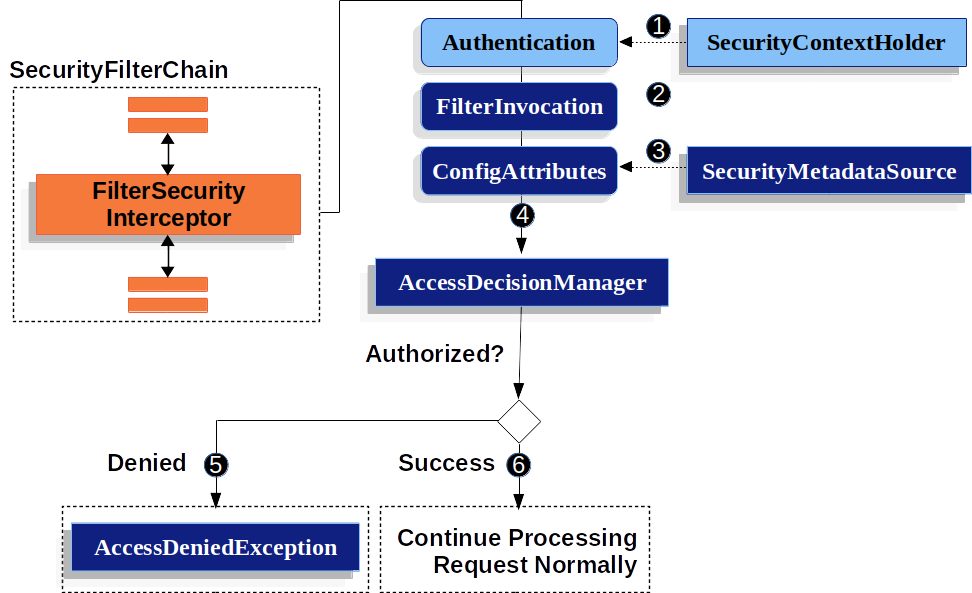|
For the latest stable version, please use Spring Security 6.2.4! |
Authorize HttpServletRequest with FilterSecurityInterceptor
|
|
This section builds on Servlet Architecture and Implementation by digging deeper into how authorization works within Servlet-based applications.
The FilterSecurityInterceptor provides authorization for HttpServletRequest instances.
It is inserted into the FilterChainProxy as one of the Security Filters.
The following image shows the role of FilterSecurityInterceptor:

![]() The
The FilterSecurityInterceptor obtains an Authentication from the SecurityContextHolder.
![]()
FilterSecurityInterceptor creates a FilterInvocation from the HttpServletRequest, HttpServletResponse, and FilterChain that are passed into the FilterSecurityInterceptor.
![]() It passes the
It passes the FilterInvocation to SecurityMetadataSource to get the ConfigAttributes.
![]() It passes the
It passes the Authentication, FilterInvocation, and ConfigAttributes to the AccessDecisionManager.
![]() If authorization is denied, an
If authorization is denied, an AccessDeniedException is thrown.
In this case, the ExceptionTranslationFilter handles the AccessDeniedException.
![]() If access is granted,
If access is granted, FilterSecurityInterceptor continues with the FilterChain, which lets the application process normally.
By default, Spring Security’s authorization requires all requests to be authenticated. The following listing shows the explicit configuration:
We can configure Spring Security to have different rules by adding more rules in order of precedence:
-
Java
-
XML
-
Kotlin
@Bean
public SecurityFilterChain filterChain(HttpSecurity http) throws Exception {
http
// ...
.authorizeRequests(authorize -> authorize (1)
.requestMatchers("/resources/**", "/signup", "/about").permitAll() (2)
.requestMatchers("/admin/**").hasRole("ADMIN") (3)
.requestMatchers("/db/**").access("hasRole('ADMIN') and hasRole('DBA')") (4)
.anyRequest().denyAll() (5)
);
return http.build();
}<http> (1)
<!-- ... -->
(2)
<intercept-url pattern="/resources/**" access="permitAll"/>
<intercept-url pattern="/signup" access="permitAll"/>
<intercept-url pattern="/about" access="permitAll"/>
<intercept-url pattern="/admin/**" access="hasRole('ADMIN')"/> (3)
<intercept-url pattern="/db/**" access="hasRole('ADMIN') and hasRole('DBA')"/> (4)
<intercept-url pattern="/**" access="denyAll"/> (5)
</http>@Bean
open fun filterChain(http: HttpSecurity): SecurityFilterChain {
http {
authorizeRequests { (1)
authorize("/resources/**", permitAll) (2)
authorize("/signup", permitAll)
authorize("/about", permitAll)
authorize("/admin/**", hasRole("ADMIN")) (3)
authorize("/db/**", "hasRole('ADMIN') and hasRole('DBA')") (4)
authorize(anyRequest, denyAll) (5)
}
}
return http.build()
}| 1 | There are multiple authorization rules specified. Each rule is considered in the order they were declared. |
| 2 | We specified multiple URL patterns that any user can access. Specifically, any user can access a request if the URL starts with "/resources/", equals "/signup", or equals "/about". |
| 3 | Any URL that starts with "/admin/" will be restricted to users who have the role "ROLE_ADMIN".
You will notice that since we are invoking the hasRole method we do not need to specify the "ROLE_" prefix. |
| 4 | Any URL that starts with "/db/" requires the user to have both "ROLE_ADMIN" and "ROLE_DBA".
You will notice that since we are using the hasRole expression we do not need to specify the "ROLE_" prefix. |
| 5 | Any URL that has not already been matched on is denied access. This is a good strategy if you do not want to accidentally forget to update your authorization rules. |
Configure FilterSecurityInterceptor with Dispatcher Types
By default, the FilterSecurityInterceptor applies to every request.
This means that if a request is dispatched from a request that was already filtered, the FilterSecurityInterceptor will perform the same authorization checks on the dispatched request.
In some scenarios, you may not want to apply authorization on some dispatcher types:
-
Java
-
XML
@Bean
SecurityFilterChain web(HttpSecurity http) throws Exception {
http
.authorizeRequests((authorize) -> authorize
.dispatcherTypeMatchers(DispatcherType.ASYNC, DispatcherType.ERROR).permitAll()
.anyRequest.authenticated()
)
// ...
return http.build();
}<http auto-config="true">
<intercept-url request-matcher-ref="dispatcherTypeMatcher" access="permitAll" />
<intercept-url pattern="/**" access="authenticated"/>
</http>
<b:bean id="dispatcherTypeMatcher" class="org.springframework.security.web.util.matcher.DispatcherTypeRequestMatcher">
<b:constructor-arg value="ASYNC"/>
<b:constructor-arg value="ERROR"/>
</b:bean>
